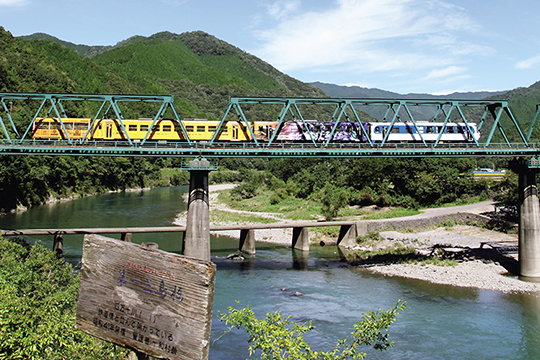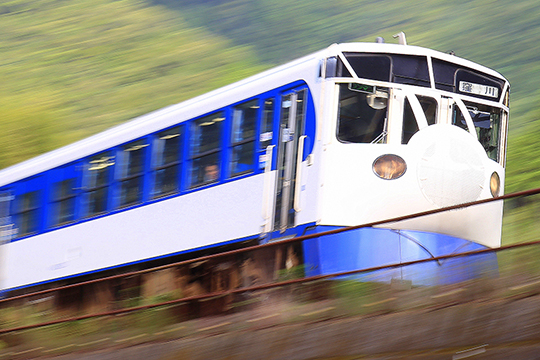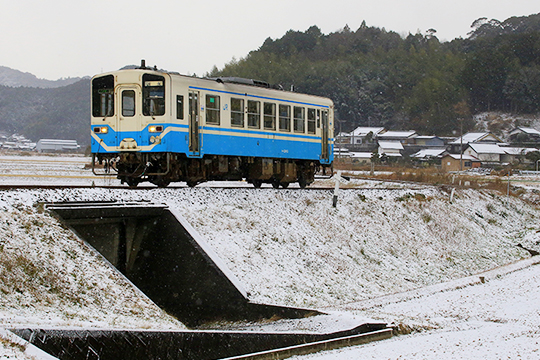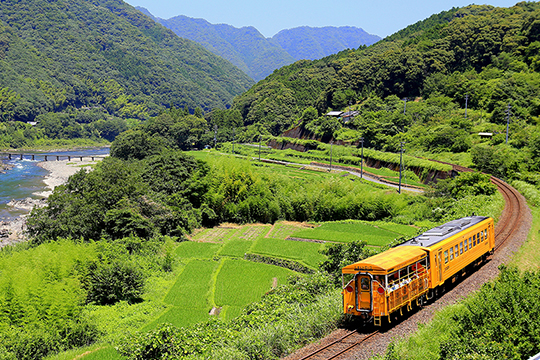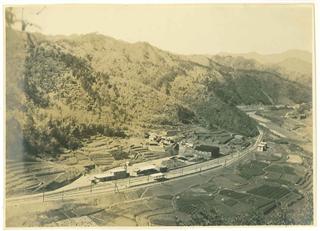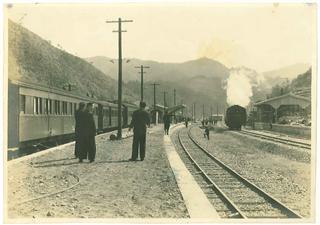About the Yodo Line
The Yodo Line is part of the JR Shikoku Railway that connects Shimanto Town, Kochi Prefecture to Uwajima City, Ehime Prefecture.
More specifically, the JR Yodo Line is the section where the line branches off from the Tosa Kuroshio Railway Nakamura Line at the Kawaoku Block Station and merges with the JR Yosan Line at Kita-Uwajima Station. Trains run between Kubokawa Station and Uwajima Station.
During the Taisho Era, the Yodo Line operated as a light railway on the Ehime Prefecture side until Showa 47 (1972) when the line between Ekawasaki Station and Wakai Station opened up. On the Kochi Prefecture side, the railroad runs almost entirely alongside the crystal clear waters of the Shimanto River. Between the Tosa-Taisho Station and the Ekawasaki Station in particular, you can see the Shimanto River alternating sides out of the train car windows upon exiting the tunnels, almost as if the train itself is running through the meandering river.
The Yodo Line is a small railway with few trains in operation, but the captivating sights alongside the railroad tracks are worthwhile to come and see!
| Wakai – Kita-Uwajima Station route distance (kilometers operated) |
76.3km/47.4mi |
|---|---|
| Track gauge | 1,067mm/42in |
| Number of stations | 20 stations (Kochi Prefecture: 9 stations, Ehime Prefecture: 11 stations)
|
| The entire track is a single track/ The entire track is non-electrified | |
| Signaling Block System | Restricted Automatic Block System (Track Circuit Detection System) |
| Top Speed | Wakai Station – Kawaoku Block Station: 110km/hr (68mi/hr) Kawaoku Block Station — Ekawasaki Station: 85km/hr (53mi/hr) Ekawasaki Station—Kita-Uwajima Station: 65km/hr (40mi/hr) |
History of the Yodo Line
| 1914 (Taisho 3), October 18 | Operation began between Uwajima and Chikanaga under Uwajima Railways. At the time, it was still a steam engine. |
|---|---|
| 1923 (Taisho 12), December 12 | Operation began between Chikanaga and Yoshino (now Yoshinobu) |
| 1931 (Showa 6), March 26 | Upon receiving approval for using gasoline power, the internal combustion railcar (“gasoline car”) started to run. |
| 1933 (Showa 8), August 1 | Uwajima Railways was nationalized and became the Uwajima Line. |
| 1939 (Showa 14) | The Kuboe Line, which would later become the Yodo Line, was recognized by the Ministry of Railways as a “Japanese National Railways Construction Route.” |
| 1941 (Showa 16), January | When personnel from the Kochi Prefecture side went to Tokyo to push for movement on opening the train lines, the completion period for the Kuboe Line was postponed for three years, setting the completion date for the Showa 22 fiscal year (1947). The reason behind this was due to the tense political situation leading up to war. Soon after, Japan plunged into the Pacific War, and construction was suspended. |
| 1941 (Showa 16), July 2 | All train lines were standardized to a gauge width of 1067mm (42in). The old line between Uwajima and Muden was discontinued, and a new line was opened between Kita-Uwajima and Muden. Kita-Uwajima Station became the railhead. Stops along the old line at Takagushi Station and Mitsuma Station were discontinued. |
| 1951 (Showa 26), November | The Dosan Line was extended to Kubokawa. Kubokawa Station began operating. |
| 1953 (Showa 28), March 26 | Operation began between Yoshinobu and Ekawasaki. (Pictured is Ekawasaki Station at the time of opening.)
|
| 1957 (Showa 32), July | Permission was granted for the construction of the Kuboe Line (between Kubokawa and Ekawasaki). |
| 1961 (Showa 36) | The construction of the Kuboe Line started. However, the plans for building a dam in Taisho Town (now Shimanto Town Taisho) were actualized, and there were concerns if it was necessary to raise or bypass a section of the planned railway line. |
| 1963 (Showa 38), April 6 | The National Railway presidents of the time were present for the Kuboe Line construction recommencement ceremony held at Ekawasaki Station. |
| 1973 (Showa 48), November | Both the Uwajima and Kuboe Lines were bolted together, and the railways within Shikoku were connected in a continuous loop for the first time. |
| 1974 (Showa 49), March 1 | Operation began between all of Ekawasaki and Wakai. The line was renamed the Yodo Line. ※ According to the records of the former Towa Village (now Shimanto Town)… “With the opening of the Yodo Line, transportation fares became one fourth of the price of bus fares up until then, and a trip to Kochi City, the prefectural capital, that previously took two days was now possible to complete in a day. In around 1980, a two-car train began operation. More or less seven trains ran per day, and passengers were very minimal (this remains unchanged). According to the financial numbers of the Showa 53 (1978) fiscal year, in order to have earnings of 100\, an expenditure of 646\ was required, and there was a total deficit of approximately 800,000,000\ for the year. At the time, there were notices posted around the Towa Village Office under the mayor’s name saying to ‘do your utmost to use the train for commuting to work and business trips.’” |
| 1980 (Showa 55), November | Due to the passage of the Japanese National Railways Management Promotion of Reconstruction Special Measures Act, the Yodo Line was in danger of being discontinued. In response to this, the residents of the cities, towns, and villages that lined the railroad tracks appealed for the continued existence of the Yodo Line and started various campaigns. |
| 1981 (Showa 56), March 3 | After a government ordinance determined the standard for deciding whether to discontinue Japanese National Railway local train lines in a deficit, the Yodo Line fell under the exception of “alternate passages of transport deemed underdeveloped” and was removed from the list of railroad lines to be discontinued. It was decided that it would continue to be preserved until Showa 60 (1985). |
| 1984 (Showa 59) | Original model of the trolley train (Tora 45000) began operating. |
| 1987 (Showa 62), April 1 | Following the break up and privatization of the Japanese National Railways, management was transferred to the Shikoku Railway Company (JR Shikoku). |
| 1989 (Heisei 1), November | The SL Shimanto started running between Uwajima and Tosa Taisho. |
| 1997 (Heisei 9), July | The Yodo Line was given the nickname of the “Shimanto Green Line” from a public advertisement. |
| 2001 (Heisei 13), March | The trolley train was redesigned as the Crystal Clear Shimanto. |
Information about the Joint Committee
Kochi Prefecture Joint Committee Promoting the Use of the Yodo Line
- Offices
- Shimanto City West Tosa General Branch Office Tel. 0880-52-1111
Shimanto Town Office Planning Division Tel. 0880-22-3124
Joint Committee Mission Statement
Our goal is to promote the use of the Yodo Line for its continued preservation for the sake of the will of the residents who live along the railroad and to devise plans for growth of the region’s industry, education, culture, etc. (By-Laws Article 2 in effect since November 9, Showa 59)
Participating Municipalities
Kochi Prefecture
Shimanto City (previously West Tosa Village and Nakamura City)
Shimanto Town (previously Towa Village, Taisho Town, and Kubokawa Town)
Ehime Prefecture Joint Committee Promoting the Use of the Yodo Line
- Offices
-
Uwajima City Planning Information Division Tel.0895-49-7003
Kihoku Town Planning Promotion Division Tel.0895-45-1111
Matsuno Town Hometown Creation Division Tel.0895-42-1116
- YODOSEN Supporter Office
-
Ehime Prefecture Nanyo Regional Bureau Regional Policy Division
Tel. 0895-28-6143
Joint Committee Mission Statement
Our goal is to promote the use of the Yodo Line for its continued preservation and to devise plans for growth of the region’s industry, education, culture, etc. (By-Laws Article 2 in effect since November 15, Heisei 22)
Participationg Municipalities
Ehime Prefecture
Uwajima City
Kihoku Town
Matsuno Town


